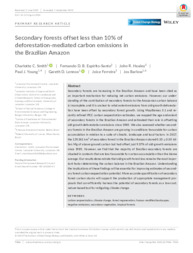Secondary forests offset less than 10% of deforestation-mediated carbon emissions in the Brazilian Amazon.
Secondary forests offset less than 10% of deforestation-mediated carbon emissions in the Brazilian Amazon.
Author(s): SMITH, C. C.; ESPÍRITO-SANTO, F. D. B.; HEALEY, J. R.; YOUNG, P. J.; LENNOX, G. D.; FERREIRA, J. N.; BARLOW, J.
Summary: Secondary forests are increasing in the Brazilian Amazon and have been cited as an important mechanism for reducing net carbon emissions. However, our under-standing of the contribution of secondary forests to the Amazonian carbon balance is incomplete, and it is unclear to what extent emissions from old-growth deforesta-tion have been offset by secondary forest growth. Using MapBiomas 3.1 and re-cently refined IPCC carbon sequestration estimates, we mapped the age and extent of secondary forests in the Brazilian Amazon and estimated their role in offsetting old-growth deforestation emissions since 1985. We also assessed whether second-ary forests in the Brazilian Amazon are growing in conditions favourable for carbon accumulation in relation to a suite of climatic, landscape and local factors. In 2017, the 129,361 km2 of secondary forest in the Brazilian Amazon stored 0.33± 0.05 bil-lion Mg of above-ground carbon but had offset just 9.37% of old-growth emissions since 1985. However, we find that the majority of Brazilian secondary forests are situated in contexts that are less favourable for carbon accumulation than the biome average. Our results demonstrate that old-growth forest loss remains the most impor-tant factor determining the carbon balance in the Brazilian Amazon. Understanding the implications of these findings will be essential for improving estimates of second-ary forest carbon sequestration potential. More accurate quantification of secondary forest carbon stocks will support the production of appropriate management pro-posals that can efficiently harness the potential of secondary forests as a low-cost, nature-based tool for mitigating climate change.
Publication year: 2020
Types of publication: Journal article
Unit: Embrapa Eastern Amazon
Observation
Some of Embrapa's publications are published as ePub files. To read them, use or download one of the following free software options to your computer or mobile device. Android: Google Play Books; IOS: iBooks; Windows and Linux: Calibre.
Access other publications
Access the Agricultural Research Database (BDPA) to consult Embrapa's full library collection and records.
Visit Embrapa Bookstore to purchase books and other publications sold by Embrapa.

